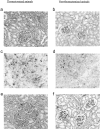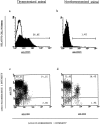Role of the thymus in transplantation tolerance in miniature swine. I. Requirement of the thymus for rapid and stable induction of tolerance to class I-mismatched renal allografts
- PMID: 9254648
- PMCID: PMC2199031
- DOI: 10.1084/jem.186.4.497
Role of the thymus in transplantation tolerance in miniature swine. I. Requirement of the thymus for rapid and stable induction of tolerance to class I-mismatched renal allografts
Abstract
The almost uniform failure in transplant patients of tolerance-inducing regimens that have been found to be effective in rodents, has made it necessary to examine large animal models before testing of new approaches clinically. Miniature swine have been shown to share many relevant immunologic parameters with humans, and because of their reproducible genetics, have proved extremely useful in providing such a large animal model. We have previously shown that indefinite systemic tolerance to renal allografts in miniature swine is induced in 100% of cases across a two-haplotype class I plus minor histocompatibility antigen disparity by a 12-d course of Cyclosporine A (CyA), in contrast to irreversible rejection observed uniformly without CyA treatment. In the present study, we have examined the role of the thymus during the induction of tolerance by performing a complete thymectomy 21 d before renal transplantation. This analysis demonstrated a striking difference between thymectomized and nonthymectomized animals. Thymectomized swine developed acute cellular rejection characterized by a T cell (CD25(+)) infiltrate, tubulitis, endothelialitis and glomerulitis, and anti-donor CTL reactivity in vitro. Nonthymectomized and sham thymectomized animals had a mild T cell infiltrate with few CD25(+) cells and no anti-donor CTL response in vitro. These results indicate that the thymus is required for rapid and stable induction of tolerance.
Figures






References
-
- French ME, Batchelor JR. Enhancement of renal allografts in rats and man. Transplant Rev. 1972;13:115–141. - PubMed
-
- Waldmann H, Cobbold S. The use of monoclonal antibodies to achieve immunological tolerance. Immunol Today. 1993;14:247–251. - PubMed
-
- Cosimi AB, Delmonico FL, Wright JK, Wee SL, Preffer FI, Jolliffe LK, Colvin RB. Prolonged survival of nonhuman primate renal allograft recipients treated only with anti-CD4 monoclonal antibody. Surgery (St Louis) 1990;108:406–413. - PubMed
-
- Isobe M, Yagita H, Okumura K, Ihara A. Specific acceptance of cardiac allograft after treatment with antibodies to ICAM-1 and LFA-1. Science (Wash DC) 1992;255:1125–1127. - PubMed
-
- Sachs DH, Leight G, Cone J, Schwartz S, Stuart L, Rosenberg S. Transplantation in miniature swine. I. Fixation of the major histocompatibility complex. Transplantation (Baltimore) 1976;22:559–567. - PubMed
Publication types
MeSH terms
Substances
Grants and funding
LinkOut - more resources
Full Text Sources
Other Literature Sources
Medical

